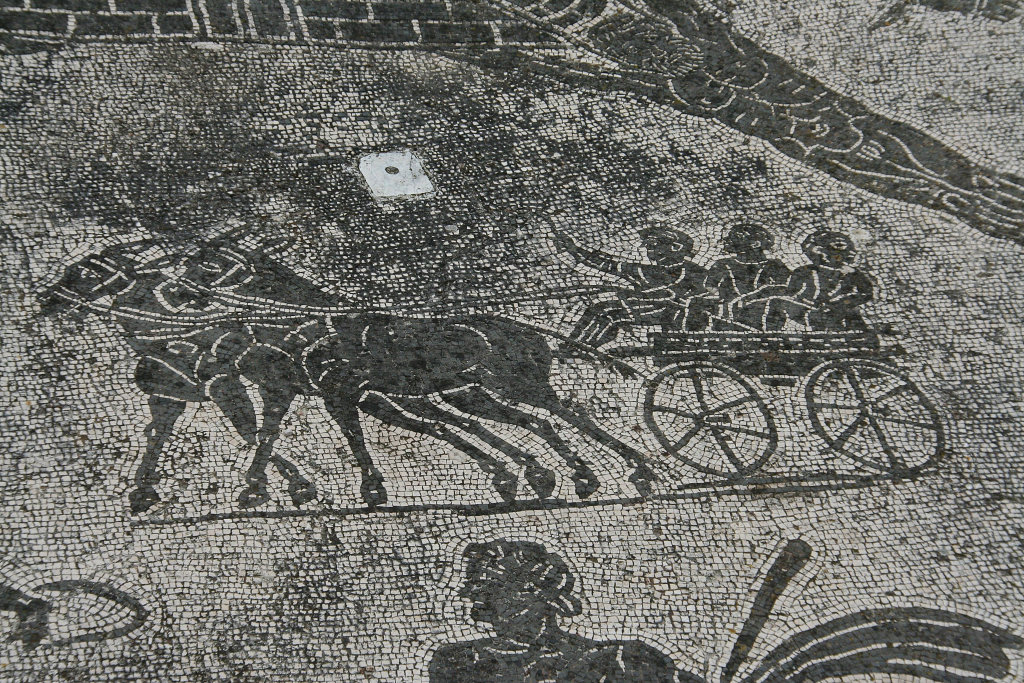Transport on the Tiber
For people the fastest way to travel to Rome was by using the ancient equivalent of taxis. These are depicted on a mosaic in baths in Ostia.

A mosaic showing a coach with two passengers, in the Baths of the Coachmen in Ostia. Photo: Klaus Heese.
Road transport is expensive however, especially for bulk commodities such as grain, wine and olive oil. Therefore transportation took place across the Tiber, using tow boats pulled by men or oxen. They were called naves codicariae. Sailing upstream to Rome was not an option. The current is strong, and because the Tiber is a meandering river the wind will often be unfavourable. Constant tacking from one bank of the river to the other would be necessary, and it would then be difficult to avoid collisions. In the sixth century Procopius explained it as follows:
| Now when the merchants reach the harbour [Portus] with their ships, they unload their cargoes and place them in the barges, and sail by way of the Tiber to Rome; but they do not use sails or oars at all, for the boats cannot be propelled in the stream by any wind since the river winds about exceedingly and does not follow a straight course, nor can oars be employed, either, since the force of the current is always against them. Instead of using such means, therefore, they fasten ropes from the barges to the necks of oxen, and so draw them just like waggons up to Rome. |
| Procopius, De Bello Gothico V, XXVI,11-12. |
Sails and oars can be seen on a few reliefs of tow boats, but they were helpful at most. A main characteristic of the barges was a single mast to which the ropes for pulling were attached. The mast sometimes had small protuberances, and could be lowered.

A relief of a tow boat with a lowered mast, in the Cathedral of Salerno.
Sharp bends in the river and obstacles, such as the piers of bridges, could have been overcome by passing ropes around a kind of column. This solution is shown in a drawing of barges on the Tiber from the late 17th century. A capstan or winch may also have been used, and seems to be depicted on a mosaic of a tow boat that we saw earlier.

A drawing of a tow boat on the Tiber by Cornelius Meyer (1685, fig. 22).

Detail of a mosaic showing a tow boat with a possible capstan or winch.
Square of the Corporations, statio 25. Photo: Klaus Heese.
A distance of about 32 kilometers had to be covered, including the meanders of the river. We only have one source for the duration of the journey. Philostratus describes a journey of two men and says: "They sailed from Dikaearchia [Puteoli], and on the third day they put in to the mouth of the Tiber from which the sailing upstream (anaplous) to Rome has the same duration (summetros)" (Life of Apollonius of Tyana 7,16). This would mean that the journey from Ostia to Rome would take three days. That is surprising: the two could have walked to Rome in six hours, taking a road that avoided many of the river's bends. Perhaps the two men were forced to use a slow tow boat for their luggage.[1] A duration of three days for the cargo boats, including loading and unloading, is not unreasonable. Before the arrival of the steam train, tow boats for passengers were used in countries like The Netherlands and Great Britain, often in canals dug for this purpose. The speed of a such a barge, pulled by a trotting horse, was seven kilometers per hour. Cargo boats, of course, travelled much more slowly.

Relief showing the pulling of a tow boat. Found in Cabrières-d'Aigues, France. Avignon, Musée Lapidaire. Photo: Wikimedia, Rvalette.
We should perhaps imagine groups of boats, using towpaths along the river, most likely on both banks. No traces of these paths have been found, and we probably never will: in modern times the banks of the Tiber have been reinforced extensively. Presumably the boats started and stopped at fixed times. The crews will have slept in the boats at night. Perhaps there were a few pubs along the route.
The return journey was simply a matter of drifting downstream. Return cargoes could be bricks and tufa, produced and quarried on the riverbanks and in the hills surrounding Rome, and travertine, quarried in Tivoli. All walls in Ostia and Portus are made of bricks and small tufa blocks, all thresholds are of travertine.

The modern travertine quarries in Tivoli. Photo: Wikimedia, Albarubescens.
The banks and bed of the Tiber fell under the jurisdiction of a special official, the curator riparum et alvei Tiberis (a famous holder of the office was Pliny the Younger). His staff had offices (stationes) in Rome and Ostia. Boundary markers between public and private land were placed by the Tiber authority on both banks of the Tiber, also in Ostia.
[1] The Loeb translation by F.C. Conybeare uses a second meaning of summetros, "moderate": "... from which it is a fairly short sail to Rome". That would imply the use of rowing boats or fast tow boats for passengers, but the latter would have interfered with the cargo boats.